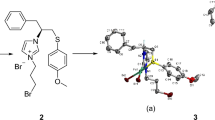Abstract
Complexes of pyridine-2-aldoxime (Hpox) with iron(II) and chromium(III) of type, [Fe(Hpox)2 X 2] (X=Cl, Br, I or NCS); [Cr(Hpox)3]Cl3·3 H2O; [Cr(Hpox)2 X 2]ClO4 (X=F, Cl or Br) and [Cr(Hpox)2(H2O)2]Br3·H2O were prepared and characterized by analytical X-ray powder diffraction, magnetism, vibrational (conventional and far-infrared) and electronic spectroscopy techniques. X-ray and electronic spectral data indicate that all the complexes except [Cr(Hpox)3]Cl3·3 H2O havetrans-pseudo-octahedral microsymmetry around the metal ion. Infrared spectral data indicate that the ligand, Hpox, behaves like a neutral ligand and coordinates to the metal ion through pyridine nitrogen atom and oxime nitrogen atom in all these complexes. The magnetic susceptibilities of chromium(III) complexes, measured over a temperature range 300–78 K, are independent of temperature whereas the magnetic moments of iron(II) complexes over a temperature range 300–20 K are dependent of temperature. The observed temperature dependence of magnetic moments of iron(II) complexes was used to evaluate the magnitude of orbital reduction factor,k, the low-symmetry distortion parameter, Δ, and the extent of reduction in spin-orbital coupling, λ. In all these iron(II) complexes the magnetic results indicate the presence of an orbitally non-degenerate,5B2g, ground state. Magnetically unperturbed and perturbedMössbauer spectra of iron(II) complexes at various temperatures have also been reported. Magnetically perturbedMössbauer spectra of iron(II) complexes at 4.2 K in an axial field of 60kGauss indicate that the principal component of electric field gradient tensor is positive and consistent with5B2g ground electronic state in a tetragonal (D 4h) local site symmetry.
Zusammenfassung
Es wurden Komplexe von Pyridin-2-aldoxim (Hpox) mit Fe(II) und Cr(III) vom Typ [Fe(Hpox)2 X 2] (X=Cl, Br, I, NCS), [Cr(Hpox)3]Cl3·3 H2O, [Cr(Hpox)2 X 2]ClO4 (X=F, Cl, Br) und [Cr(Hpox)2(H2O)2]Br3·H2O hergestellt. Charakterisierung und Diskussion von Geometrie und Bindungsverhalten in den Komplexen erfolgte auf Grund von analytischen Daten, Röntgen-Pulveraufnahmen, Elektronenanregungsspektroskopie, Infrarotspektroskopie, magnetischen Messungen undMössbauer-Spektroskopie.
Similar content being viewed by others
References
G. Less, F. Holmes, A. E. Underhill, andD. B. Powell, J. Chem. Soc.A 1971, 337.
F. Holmes, G. Lees, andA. E. Underhill, J. Chem. Soc.A 1971, 999.
M. Mohan, H. C. Khera, S. G. Mittal, andA. K. Sirivastava, Acta Chim. (Hung.)91, 417 (1976).
M. Mohan, H. C. Khera, S. G. Mittal, andA. K. Sirivastava, Curr. Sci.46, 211 (1977).
M. Mohan, H. C. Khera, S. G. Mittal, andA. K. Sirivastava, Indian J. Chem.15 A, 696 (1977).
M. Mohan, S. G. Mittal, H. C. Khera, andA. K. Sirivastava, Gazz. Chim. Italiana107, 393 (1977).
M. Mohan, S. G. Mittal, H. C. Khera, andA. K. Sirivastava, Gazz. Chim. Italiana108, 585 (1978).
M. Mohan, S. G. Mittal, H. C. Khera, andA. K. Sirivastava, Mh. Chem.109, 357 (1978).
G. Brauer, Handbook of Preparative Inorganic Chemistry,2, 1359. New York: Academic Press. 1963.
F. J. Welcher, The Analytical uses of E.D.T.A. Van Nostrand Company, Inc. 1965.
I. Sotofte andS. E. Rasmussen, Acta Chem. Scand.21, 2028 (1967).
R. A. Krause, N. B. Colthup, andD. H. Busch, J. Phys. Chem.65, 2216 (1961).
R. E. Rundle andM. Parasol, J. Chem. Phys.20, 1487 (1952).
A. Fujita, A. Nakahara, andR. Tsuchida, J. Chem. Phys.23, 1541 (1955).
P. E. Figgins andD. H. Busch, J. Phys. Chem.65, 2236 (1961).
S. P. Sinha, Spectrochim Acta20, 879 (1964).
J. H. S. Green, W. Kynaston, andH. M. Paisley, Spectrochim Acta19, 549 (1963).
N. S. Gill andH. J. Kingdon, Aust. J. Chem.19, 2197 (1966).
G. Zerbi, J. Overend, andB. Grawford, J. Chem. Phys.38, 122 (1963).
N. S. Gill, R. H. Nuttall, D. E. Scaife, andD. W. A. Sharp, J. Inorg. Nucl. Chem.18, 79 (1961).
J. L. Burmeister, Coordn. Chem. Rev.1, 205 (1966);3, 225 (1968).
B. J. Hathaway andA. E. Underhill, J. Chem. Soc.1961, 3091.
R. J. H. Clark andC. S. Williams, Inorg. Chem.4, 350 (1965).
C. W. Frank andL. B. Rogers, Inorg. Chem.5, 615 (1966).
J. Burgress, Spectrochim Acta24 A, 277 (1968).
R. J. H. Clark andC. S. Williams, Spectrochim Acta23 A, 1055 (1967).
R. G. Inskeep, J. Inorg. Nucl. Chem.24, 763 (1962).
B. N. Figgis, J. Lewis, F. E. Mabbs, andG. A. Webb, J. Chem. Soc.1967, 442.
C. D. Burbridge andD. M. L. Goodgame, J. Chem. Soc.A 1967, 694.
G. A. Renovitch andW. A. Baker, jr., J. Chem. Soc.A 1969, 75.
C. D. Burbridge, D. M. L. Goodgame, andM. Goodgame, J. Chem. Soc.A 1967, 349.
G. M. Bancroft andR. H. Platt, Advan. Inorg. Chem. Radiochem.15, 59 (1972).
D. S. McClure, Advances in the Chemistry of Coordination Compounds, p. 498 (S. Kirschner, ed.). New York: Macmillan. 1961.
A. B. P. Lever, Inorganic Electronic Spectroscopy, p. 205. Amsterdam: Elsevier. 1968.
A. B. P. Lever, Coordn. Chem. Reg.3, 119 (1968).
L. S. Forster, Transition Metal Chem.5, 1 (1969).
J. R. Perumareddi, Coordn. Chem. Rev.4, 73 (1969).
J. G. Lerup andC. E. Schaffer, Progress in Coordination Chemistry, p. 500 (M. Cais, ed.). Amsterdam: Elsevier. 1968.
H. Yamatera, Bull Chem. Soc. Japan31, 95 (1958).
Author information
Authors and Affiliations
Rights and permissions
About this article
Cite this article
Mohan, M., Mittal, S.G., Khera, H.C. et al. Transition metal chemistry of oxime containing ligands, VII. Monatshefte für Chemie 111, 63–79 (1980). https://doi.org/10.1007/BF00938718
Received:
Revised:
Accepted:
Issue Date:
DOI: https://doi.org/10.1007/BF00938718




